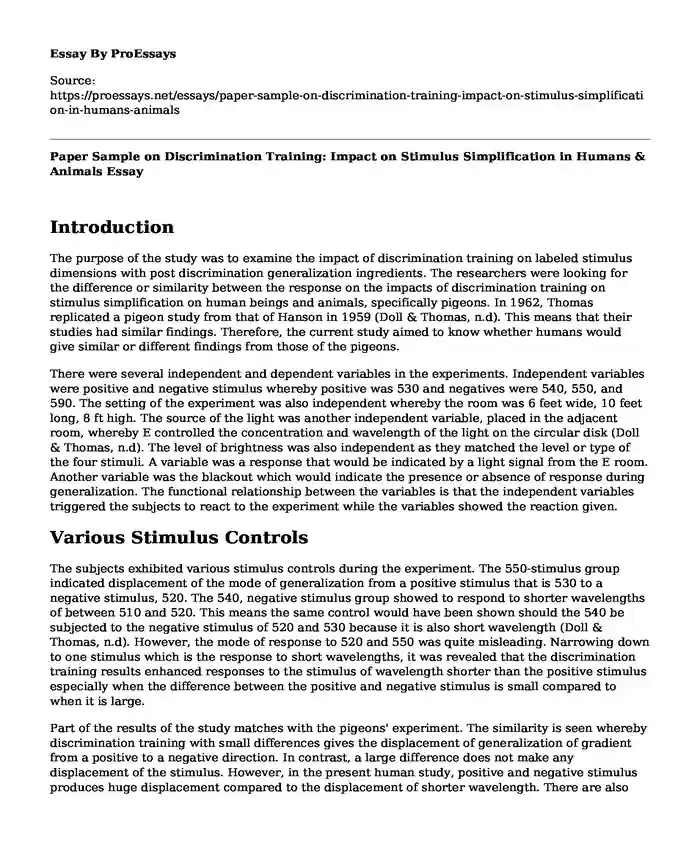Introduction
The purpose of the study was to examine the impact of discrimination training on labeled stimulus dimensions with post discrimination generalization ingredients. The researchers were looking for the difference or similarity between the response on the impacts of discrimination training on stimulus simplification on human beings and animals, specifically pigeons. In 1962, Thomas replicated a pigeon study from that of Hanson in 1959 (Doll & Thomas, n.d). This means that their studies had similar findings. Therefore, the current study aimed to know whether humans would give similar or different findings from those of the pigeons.
There were several independent and dependent variables in the experiments. Independent variables were positive and negative stimulus whereby positive was 530 and negatives were 540, 550, and 590. The setting of the experiment was also independent whereby the room was 6 feet wide, 10 feet long, 8 ft high. The source of the light was another independent variable, placed in the adjacent room, whereby E controlled the concentration and wavelength of the light on the circular disk (Doll & Thomas, n.d). The level of brightness was also independent as they matched the level or type of the four stimuli. A variable was a response that would be indicated by a light signal from the E room. Another variable was the blackout which would indicate the presence or absence of response during generalization. The functional relationship between the variables is that the independent variables triggered the subjects to react to the experiment while the variables showed the reaction given.
Various Stimulus Controls
The subjects exhibited various stimulus controls during the experiment. The 550-stimulus group indicated displacement of the mode of generalization from a positive stimulus that is 530 to a negative stimulus, 520. The 540, negative stimulus group showed to respond to shorter wavelengths of between 510 and 520. This means the same control would have been shown should the 540 be subjected to the negative stimulus of 520 and 530 because it is also short wavelength (Doll & Thomas, n.d). However, the mode of response to 520 and 550 was quite misleading. Narrowing down to one stimulus which is the response to short wavelengths, it was revealed that the discrimination training results enhanced responses to the stimulus of wavelength shorter than the positive stimulus especially when the difference between the positive and negative stimulus is small compared to when it is large.
Part of the results of the study matches with the pigeons' experiment. The similarity is seen whereby discrimination training with small differences gives the displacement of generalization of gradient from a positive to a negative direction. In contrast, a large difference does not make any displacement of the stimulus. However, in the present human study, positive and negative stimulus produces huge displacement compared to the displacement of shorter wavelength. There are also differences in responses and displacement between various groups of subjects. Some subjects would respond to certain stimuli while others could not.
Conclusion
These results imply that there is a similarity in the reaction of both human beings and the pigeons when subjected to a similar stimulus. The differences in responses and categorization of positive stimuli in the current study are because individuals have different levels of understanding and interpreting things. Also, some individuals pay more attention to highlighted materials and less to the materials not highlighted. The subjects who were told to remember the positive stimulus at the beginning of the experiment responded to the stimulus and at times failed to respond to the negative stimulus just because they had not to be cautioned about the negative stimulus.
Reference
Doll, T. J., & Thomas, D. R. (n.d.). EFFECTS OF DISCRIMINATION TRAINING ON STIMULUS GENERALIZATION FOR HUMAN SUBJECTS.
Cite this page
Paper Sample on Discrimination Training: Impact on Stimulus Simplification in Humans & Animals. (2023, Oct 03). Retrieved from https://proessays.net/essays/paper-sample-on-discrimination-training-impact-on-stimulus-simplification-in-humans-animals
If you are the original author of this essay and no longer wish to have it published on the ProEssays website, please click below to request its removal:
- Report Example: Childhood Obesity Among Year 6 Pupils in London Borough of Lewisham
- Essay Sample on Concept of Equality
- Domestic Violence and the Minority Woman Essay Example
- Terrorism in India: Decades of Risk & Political Intimidation - Research Paper
- Paper Example on Prevalence and Support for Domestic Violence Survivors Presenting at Emergency Departments
- Essay Example on Adopting National Identity Cards: Pros & Cons
- Essay An Intervention Helpful for Group Process







